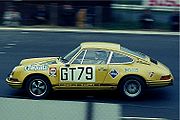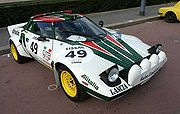
Group 4 (racing)
Encyclopedia

Rallying
Rallying, also known as rally racing, is a form of auto racing that takes place on public or private roads with modified production or specially built road-legal cars...
, as regulated by the FIA
Fédération Internationale de l'Automobile
The Fédération Internationale de l'Automobile is a non-profit association established as the Association Internationale des Automobile Clubs Reconnus on 20 June 1904 to represent the interests of motoring organisations and motor car users...
. The Group 4 class was replaced by Group B
Group B
Group B was a set of regulations introduced in 1982 for competition vehicles in sportscar racing and rallying regulated by the FIA. The Group B regulations fostered some of the quickest, most powerful and sophisticated rally cars ever built. However, a series of major accidents, some fatal, were...
for the 1983 season.
Production requirements
Prior to 1966, the FIA’s Group 4 classification applied to Sports Cars which were in compliance with FIA Appendix C regulations. It also included recognised Series Touring Cars, Improved Touring Cars and Grand Touring Cars which had been modified beyond the respective Group 1, Group 2 or Group 3 regulations under which they had been homologatedHomologation (motorsport)
In motorsports, homologation is the approval process a vehicle, race track or standardised part must go through to race in a given league or series. The regulations and rules that must be met are generally set by the series' sanctioning body...
. In 1966, an overhaul of FIA categories saw Group 4 Sports Cars redefined such that they were now subject to a minimum production requirement of 50 units in 12 consecutive months and had to be fitted with all equipment necessary for use on public roads. A 5000cc engine capacity limit was applied for 1968 and the minimum production requirement was reduced to 25 units for the 1969 season.
For 1969, Appendix J of the FIA International Sporting Code defined groups for Touring cars
Touring car racing
Touring car racing is a general term for a number of distinct auto racing competitions in heavily-modified street cars. It is notably popular in Argentina, Australia, Brazil, Germany, Japan, Scandinavia and Britain.-Characteristics of a touring car:...
, Grand Touring cars and Sports car
Sports car
A sports car is a small, usually two seat, two door automobile designed for high speed driving and maneuverability....
s as follows: (numbers between brackets are required minimum production in 12 consecutive months).
- Group 1: series-production touring cars (5,000)
- Group 2: special touring cars (1,000)
- Group 3: grand touring cars (500)
- Group 4: sports cars (25)
- Group 5: special touring cars
- Group 6: prototype-sports carsGroup 6 (racing)Group 6 was the official designation applied by the FIA to two motor racing classifications, the Prototype-Sports Car category from 1966 to 1971 and the Two-Seater Racing Cars class from 1976 to 1982.-Group 6 Prototype-Sports Cars :...
For 1970, the limited production sports car category was renamed from Group 4 to Group 5
Group 5 (racing)
Group 5 was an FIA motor racing classification which was applied to four distinct categories during the years 1966 to 1982. Initially Group 5 regulations defined a Special Touring Car category and from 1970 to 1971 the classification was applied to limited production Sports Cars restricted to 5...
and, in the same year, Group 4 became the class for special grand touring cars with minimum production of 500 in 12 consecutive months
For 1971, the relevant FIA classifications were as follows:
- Group 1: series-production touring cars (5,000)
- Group 2: touring cars (1,000)
- Group 3: series-production grand touring cars (1,000)
- Group 4: special grand touring cars (500)
- Group 5: sports carsGroup 5 (racing)Group 5 was an FIA motor racing classification which was applied to four distinct categories during the years 1966 to 1982. Initially Group 5 regulations defined a Special Touring Car category and from 1970 to 1971 the classification was applied to limited production Sports Cars restricted to 5...
(25) - Group 6: prototype-sports cars
In 1976, the Group 4 production requirement was reduced to 400 in 24 months.
Racing

Ford GT40
The Ford GT40 was a high performance sports car and winner of the 24 hours of Le Mans four times in a row, from 1966 to 1969...
Mk II & Mk IV raced for outright victories, the 4.7L GT40 Mk I entries were competing for Group 4 class wins. Indeed competitors in the two categories were competing for two different championships, the Group 6 cars for the International Championship for Sports-Prototypes and the Group 4 cars for the International Championship for Sports Cars.
In 1968, the rules were changed, so that prototypes were limited to 3.0L, but Sports cars of up to 5.0L could be still be entered. It was also announced that the minimum production figure for the Group 4 sports cars would be reduced to 25 cars for 1969. With larger engines than the prototypes, the Group 4 cars were now in contention for outright race wins. The Ford GT40 was the winner at Le Mans
24 Hours of Le Mans
The 24 Hours of Le Mans is the world's oldest sports car race in endurance racing, held annually since near the town of Le Mans, France. Commonly known as the Grand Prix of Endurance and Efficiency, race teams have to balance speed against the cars' ability to run for 24 hours without sustaining...
in both 1968
1968 24 Hours of Le Mans
The 1968 24 Hours of Le Mans was the 36th Grand Prix of Endurance, and took place on September 28 and 29 1968. It was the tenth and final round of the World Sportscar Championship....
and 1969
1969 24 Hours of Le Mans
The 1969 24 Hours of Le Mans was the 37th Grand Prix of Endurance, and took place on June 14 and 15 1969. It was the eighth round of the 1969 International Championship for Makes....
. Porsche
Porsche
Porsche Automobil Holding SE, usually shortened to Porsche SE a Societas Europaea or European Public Company, is a German based holding company with investments in the automotive industry....
began work on a production run of 25 cars for the Porsche 917
Porsche 917
The Porsche 917 is a racecar that gave Porsche its first overall wins at the 24 Hours of Le Mans in 1970 and 1971. Powered by the Type 912 flat-12 engine of 4.5, 4.9, or 5 litres, the 917/30 variant was capable of a 0- time of 2.3 seconds, 0– in 5.3 seconds, and a top speed of over .There are 6...
. Ferrari
Ferrari
Ferrari S.p.A. is an Italian sports car manufacturer based in Maranello, Italy. Founded by Enzo Ferrari in 1929, as Scuderia Ferrari, the company sponsored drivers and manufactured race cars before moving into production of street-legal vehicles as Ferrari S.p.A. in 1947...
, with some financial help from Fiat
Fiat
FIAT, an acronym for Fabbrica Italiana Automobili Torino , is an Italian automobile manufacturer, engine manufacturer, financial, and industrial group based in Turin in the Italian region of Piedmont. Fiat was founded in 1899 by a group of investors including Giovanni Agnelli...
, produced the similar Ferrari 512
Ferrari 512
Ferrari 512 S was the designation of 25 five litre sports cars built until January 1970, related to the Ferrari P sports prototypes. The V12-powered cars were entered in the 1970 International Championship for Makes by the factory Scuderia Ferrari and private teams...
.
For the 1970 season, the Group 4 Sports car category was renamed and became Group 5 Sports Cars and Group 4 designation was applied to a new Special Grand Touring category. The new Group 4 was contested by production based cars such as the Ferrari 365 GTB/4 Daytona
Ferrari Daytona
The Ferrari 365 GTB/4, better known by the unofficial name Ferrari Daytona, is a Gran Turismo automobile produced from 1968 to 1973. It was first introduced to the public at the Paris Auto Salon in 1968 and replaced the 275 GTB/4...
, Porsche 911 Carrera RS and the De Tomaso Pantera
De Tomaso Pantera
The Pantera was a sports car produced by the De Tomaso car company of Italy from 1971 to 1991, the last one being delivered to a customer in 1992.The word "Pantera" is Italian for "Panther".-History:...
.
The Group 4 GT category was replaced by a new Group B GT class for 1983.
Rallying

Fiat 131
The Fiat 131, additionally called "Mirafiori", is a small/medium family car produced by the Italian car manufacturer Fiat from 1974 to 1984. It was exhibited at 1974 Turin Motor Show....
, Lancia Stratos
Lancia Stratos
The Lancia Stratos HF, widely and more simply known as Lancia Stratos, is a car made by Italian car manufacturer Lancia. The HF stands for High Fidelity...
and the Audi Quattro
Audi Quattro
The Audi Quattro is a road and rally car, produced by the German automobile manufacturer Audi, now part of the Volkswagen Group. It was first shown at the 1980 Geneva Motor Show on 3 March.The word quattro is derived from the Italian word for "four"...
.

